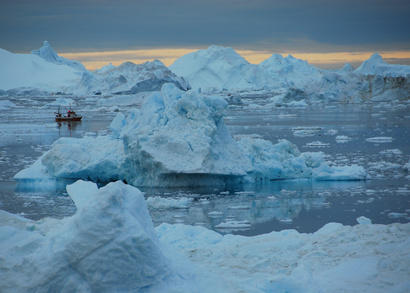The 2007 Santa Barbara, California, Light Blue Line Project, designed to demarcate a 21 foot rise in sea level if the Greenland ice sheet melts completely, was scrapped due to objections by real estate interest groups that it would depress housing prices in flood-prone areas and that such an event would be a worst case scenario and unlikely to occur in the next 100 years. However, it turns out that the Greenland ice sheet is likely to be more vulnerable to global warming than previously thought: “The temperature threshold for melting the ice sheet completely is in the range of 0.8 to 3.2 degrees Celsius of global warming, with a best estimate of 1.6 degrees above pre-industrial levels, shows a new study by scientists from the Potsdam Institute for Climate Impact Research (PIK) and the Universidad Complutense de Madrid. Today, already 0.8 degrees of global warming has been observed. Substantial melting of land ice could contribute to long-term sea-level rise of several meters, and, therefore, it potentially affects the lives of many millions of people” (source).
A recent study in Environmental Research Letters “asserts that around 32,000 km2 of US land lies within one vertical meter of the high tide line, encompassing 2.1 million housing units where 3.9 million people live. For this study, the researchers created a new model to identify the areas of US mainland that are at risk of flooding and, with a predicted sea level rise of 1 meter or more by the end of the century, suggest that the US Government’s currently designated flood zones should not be considered stable. A second study, also published March 14 in Environmental Research Letters, corroborates evidence of the risk, showing that a majority of US locations, from the 55 studied, will see a substantially higher frequency of storm-driven high water levels by the middle of the century; water levels that have previously been encountered only once-a-century” (source).
“The first study, undertaken by researchers at Climate Central and the University of Arizona, shows that at a state level, areas surrounding the Gulf appear to be the most vulnerable, whilst in terms of population, Florida is the most vulnerable, closely followed by Louisiana, California, New York, and New Jersey, illustrating significant exposure on every coast. The researchers pick out greater Los Angeles as a largely-populated city of great concern, as previous research suggests that flooding may reach rare heights more swiftly in southern California than in any other mainland US area. The second study examined the effect of heavy storms on past water levels at 55 stations across the US and combined these with estimates of future global sea level rises to predict the frequency and extent of future flooding. Co-author of both papers, Ben Strauss, researcher at Climate Central, said: ‘The sea level rise taking place right now is quickly making extreme coastal floods more common, increasing risk for millions of people where they live and work. Sea level rise makes every single coastal storm flood higher. With so many communities concentrated on US coasts, the odds for major damage get bigger every year’” (Ibid.).
For many other people, the risk is even more pressing. IPCC assessments suggest that deltas and small island states are particularly vulnerable to sea-level rise caused by both thermal expansion and ocean volume. Sea level changes have not yet been conclusively proven to have directly resulted in environmental, humanitarian, or economic losses to small island states, but the IPCC and other bodies have found this a serious risk scenario in coming decades (source). “Many Small Island States are already feeling the impact. Much of the land area of Tuvalu’s nine islands is regularly inundated by rising tides every year, internally displacing many people, contaminating meager groundwater supplies, and forcing residents to grow more salt-tolerant subsistence crops. The Maldives recently attracted media attention when its president announced that the country would be setting aside funds from its tourism industry to purchase a new homeland should the need arise. And it was reported that portions of the Solomon Islands are nearly uninhabitable due to flooding, requiring the evacuation of many families to Papua New Guinea” (source).





